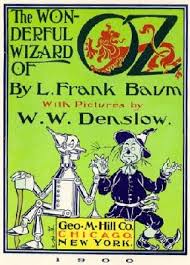
Most of us are well-acquainted with the story of Dorothy and the Wizard of Oz, which was written by L. Frank Baum. The tale revolves around a young girl, named Dorothy, who is swept up from her home in Kansas by a tornado. She finds herself in the land of Oz where she has different experiences while attempting to return to Kansas. She meets characters such as the Tin Man, the Cowardly Lion, the Scarecrow, good and bad witches and the “Wonderful Wizard of Oz” who lives in the Emerald City. Although Baum delighted his readers with this fantastical story, some have suggested that Baum had more serious thoughts running through his mind when he wrote “Oz”.
In order to understand some of the theories behind Baum’s supposed political allusions we must first understand Baum himself and the historical setting of the novel. The Wizard of Oz was published in 1900. As for Baum, he was a ardent political activist. He supported Women’s Suffrage. He also wrote some critically controversial pieces on the American West and Native Americans in 1890. This was the same year of the Wounded Knee Massacre. He advocated that for the protection of American settlers in the West, that it was necessary to annihilate Native Americans.
So, we know that Baum had some strong political views and that he wrote his crowning masterpiece at a dynamic time in American history. Many scholars have theorized about political allegorical imagery in the Wizard of Oz. The most prevalent theory claims that Baum’s fantasy story was a commentary on the Free-Silver/Gold Standard debate. There was a debate going on in the United States at the time over which currency held the most value and should thus be used in the economic markets. Advocates of Free Silver argued for the use of freely coined silver with gold at a 16-1 ratio. (This meant that sixteen ounces of silver would be worth one ounce of gold.) The Free Silver movement gained much support from farmers in the Deep South and in the Midwest. There were many activists who disagreed with the Free Silver movement. They believed that by freely coining silver at a 16-1 ratio, the gold would run out of circulation and that this would have disastrous consequences for the American economy.
Theorists who argue that Baum was alluding to the Free Silver debate have quite a few arguments on their side. First, the images from the story include the “Yellow Brick Road”, a reference to the Gold Standard, Dorothy’s silver slippers, a reference to Free Silver, and the Emerald City, a reference to the “Greenback policy” of paper money. Furthermore, Dorothy can be described as an image of the American people, lost and trying to return to “home”. The tornado may represent social upheaval in the United States. And as for the cast of characters? Well, the Tin Man may represent the American steel industry, the Scarecrow, the Midwestern farming establishment and the Cowardly Lion? Some have suggested that the Cowardly Lion either represents William Jennings Bryan or the American military during the Spanish-American War. As for Oz, the Great and Terrible, some have theorized that he represents the political establishment: scheming, aloof and utterly mean. The Winged Monkeys may be a reference to Native Americans and their evil ruler, the Wicked Witch of the West might just represent…well, the West.
Although Baum never confirmed that he purposely put political overtones in his children’s novel it is not outside the realm of possibility. In fact, it is quite plausible, considering Baum’s political activity. So, next time you read or watch the “Wizard of Oz”, remember who wrote it, when it was written and think critically about the message of this American fantasy story.
